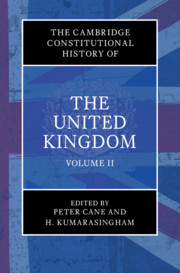Book contents
- The Cambridge Constitutional History of the United Kingdom
- The Cambridge Constitutional History of the United Kingdom
- Copyright page
- Contents
- Contributors
- Editors’ Preface
- 1 The Kingdoms of Anglo-Saxon England (450–1066)
- 2 England after the Conquest
- 3 England in the Thirteenth Century
- 4 England in the Fourteenth Century
- 5 England in the Fifteenth Century
- 6 England in the Sixteenth Century
- 7 The English Constitution in the Seventeenth Century
- 8 A European Perspective
- 9 Wales before Annexation
- 10 The Scottish Constitution before 1707
- 11 The Eighteenth-Century Constitution
- 12 The Constitutional and Parliamentary History of Ireland till the Union
- 13 The United Kingdom in the Nineteenth Century
- 14 The United Kingdom in the Twentieth Century
- 15 The Twenty-First-Century Constitution
- 16 Wales since the Annexation
- 17 Scotland in the Union
- 18 Ireland in the Union
- 19 The Making of Empire
- 20 Constitution and Empire
- Index
11 - The Eighteenth-Century Constitution
Settlement and Resettlement
Published online by Cambridge University Press: 12 August 2023
- The Cambridge Constitutional History of the United Kingdom
- The Cambridge Constitutional History of the United Kingdom
- Copyright page
- Contents
- Contributors
- Editors’ Preface
- 1 The Kingdoms of Anglo-Saxon England (450–1066)
- 2 England after the Conquest
- 3 England in the Thirteenth Century
- 4 England in the Fourteenth Century
- 5 England in the Fifteenth Century
- 6 England in the Sixteenth Century
- 7 The English Constitution in the Seventeenth Century
- 8 A European Perspective
- 9 Wales before Annexation
- 10 The Scottish Constitution before 1707
- 11 The Eighteenth-Century Constitution
- 12 The Constitutional and Parliamentary History of Ireland till the Union
- 13 The United Kingdom in the Nineteenth Century
- 14 The United Kingdom in the Twentieth Century
- 15 The Twenty-First-Century Constitution
- 16 Wales since the Annexation
- 17 Scotland in the Union
- 18 Ireland in the Union
- 19 The Making of Empire
- 20 Constitution and Empire
- Index
Summary
The statute known as the Act of Settlement1 was enacted in 1701. As its name suggests, it amended or ‘settled’ the royal succession – the second such amendment in little over a decade. In 1689 the Bill of Rights2 had not only declared Prince William of Orange and his wife Princess Mary to be King William III and Queen Mary II of England, it had also vested the royal succession firstly in the survivor of them, then in Mary’s descendants, next in her younger sister Princess Anne and her descendants, and finally in the descendants of William. At the time this had seemed adequate, but circumstances had proven otherwise. William and Mary were childless, he remained a widower after her death in 1694, and none of Princess Anne’s children thrived. When the last of these died in July 1700 at the age of eleven, it appeared that the childless William III would be succeeded by the childless Anne. The Act of Settlement therefore determined that following the deaths of William and Anne, respectively, and in the absence of descendants, the Crown would pass to Princess Sophia, a granddaughter of King James I of England through her mother, Princess Elizabeth Stuart.
- Type
- Chapter
- Information
- The Cambridge Constitutional History of the United Kingdom , pp. 259 - 287Publisher: Cambridge University PressPrint publication year: 2023



